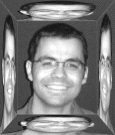Motion and orientation help to establish correspondence
| R. van Ee & B.L. Anderson (2001). Motion direction, speed, and orientation in binocular matching. Nature, 410, 690-694. |

| R. van Ee & B.L. Anderson (2001). Motion direction, speed, and orientation in binocular matching. Nature, 410, 690-694. |